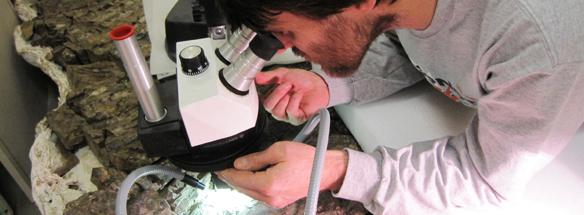Ichthyosaur
New information published for Alaska's first ichthyosaur


NOVEMBER 2014 - In 1950, a team from the U.S. Geological Survey mapping the U.S. Naval Petroleum Reserve in the western Brooks Range of Alaska stumbled on an amazing fossil – a 12-foot-long partial skeleton of a large marine reptile.
Carl Benson, a retired geophysicist with the University of Alaska Fairbanks who was on the expedition, says they recognized it right away. “We knew what it was when we found it,” he said. “We talked about it in the tent that night and during the remainder of the field season.”
It was the only vertebrate specimen they found on their five-month survey, a geologic reconnaissance that completed the first mapping of the area. The team collected lots of fossils on the trip but didn’t have room for something that big. They did cart a huge amount of specimens and rock samples back to USGS headquarters, but the ichthyosaur was the only animal specimen they found from the Triassic period, about 210 million years ago.
Based on photographs, paleontologists at the University of Alaska Museum of the North identified the fossil as an ichthyosaur, a prehistoric marine reptile that resembled modern dolphins and whales. Because of the remoteness of the area, it would be more than 50 years before the fossil could be recovered and it would take another decade before research was completed.

In this month’s issue of the Journal of Vertebrate Paleontology, UAMN earth sciences curator Pat Druckenmiller and his colleagues have confirmed the identity of the skeleton as an ichthyosaur, making it the first one found in Alaska and also the largest and most complete specimen known from the state.
Druckenmiller estimates this particular marine reptile was nearly 30 feet long, a rare fossil discovery for the state. “Ichthyosaurs were amazing animals. The Alaskan specimen is a type called a shastasaurid, which includes the largest marine reptiles to have ever lived – some rivaled the size of living blue whales.”
Ichthyosaurs are also famous for having the largest eyeballs of any animal that ever lived—some were the size of basketballs.
"This particular animal died during the Triassic Period and settled to the floor of the sea that used to occupy the place where Alaska is now located. Since then, the bottom of that sea has been pushed up to form what we now call the Brooks Range."
The fossil had other exciting stories to tell. While the specimen was being cleaned at the museum, researchers discovered an abundance of small, broken bones and shell fragments in the stomach region. “We found the last meals that this animal ate," Druckenmiller said. “Finding gut contents in an ichthyosaur of this age is very rare and provides valuable insights into the diet and ecology of Triassic ichthyosaurs. This is especially interesting considering that some of these large animals may have lacked teeth.

Recovering the fossil was no small feat. In 2002, then-curator Roland Gangloff recruited the help of the “Sugar Bears,” the Army’s B Company, 4th»Battalion, 123rd»Aviation Regiment based at Fort Wainwright. As part of a training mission, they flew a CH-47D Chinook helicopter to the remote discovery site. After the museum crew had safely encased the fossil in a sturdy plaster jacket weighing about a ton, it was loaded into the helicopter and flown to Fairbanks.
Druckenmiller said it’s amazing the fossil was ever collected at all. “If it weren’t for the help of the Sugar Bears, the fossil would still be sitting out there.”
When he joined the museum staff in 2007, Druckenmiller was excited to find the ichthyosaur skeleton in the collection. "When we brought it out of storage, we began cleaning up the skeleton and could see the bones clearly for the first time." The fossil took about a year to fully clean.
The skeleton is one of only a handful of other identifiable ichthyosaurs known from Alaska and represents the northernmost occurrence of any well-preserved Triassic ichthyosaur in North America. Druckenmiller plans to display the 210-million-year-old specimen in the museum’s next special exhibit,»Expedition Alaska: Dinosaurs, opening in the summer of 2015.
ON THE WEB: »https://www.uaf.edu/museum/collections/earth/
ARTICLE:» http://bit.ly/jvpakichthy
SPECIMEN RECORDS: »http://bit.ly/uamnarctosichthy
Links
Researchers identify species, last meal of ancient Alaska marine reptile»(Alaska Dispatch News; Nov. 25, 2014)
210-million-year-old ichthyosaur found in Alaska's Brooks Range identified (Fairbanks Daily News-Miner; Nov. 25, 2014)
